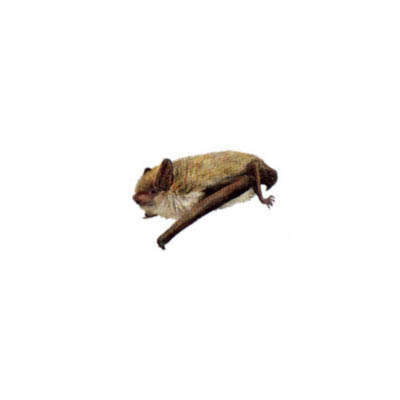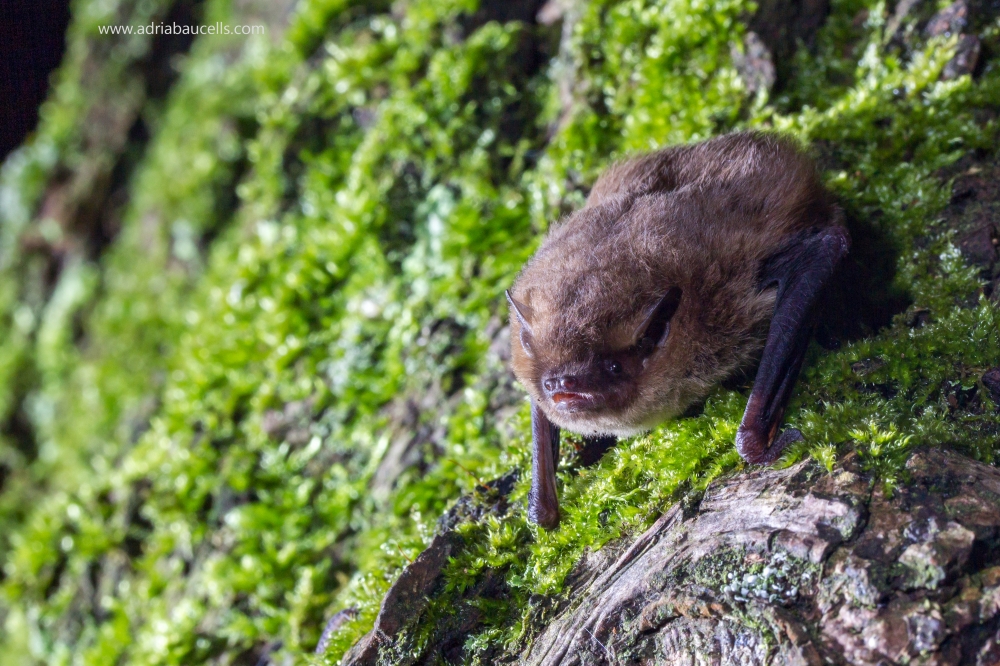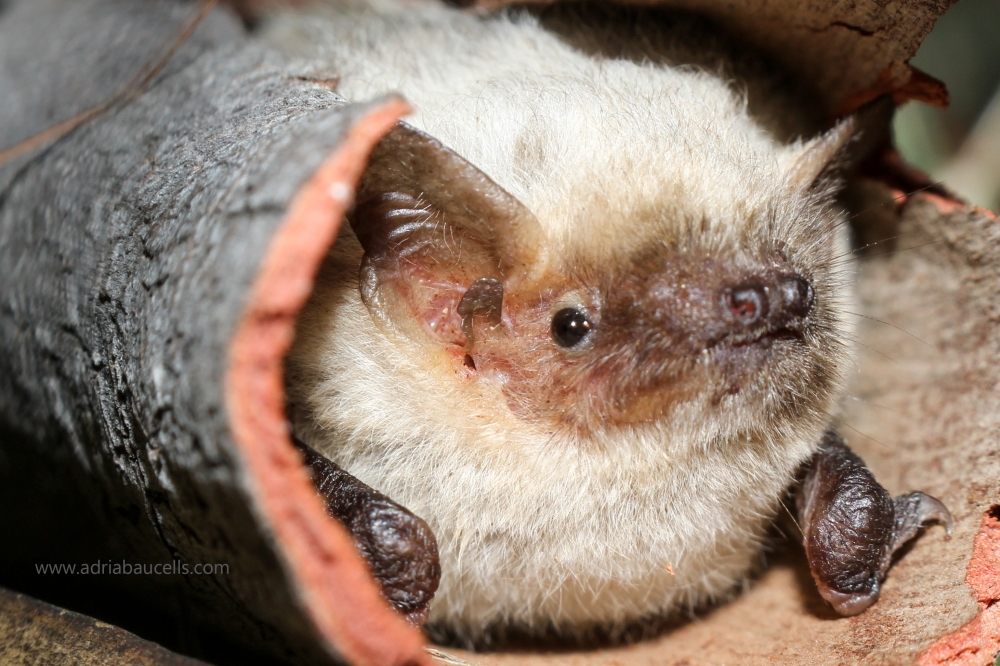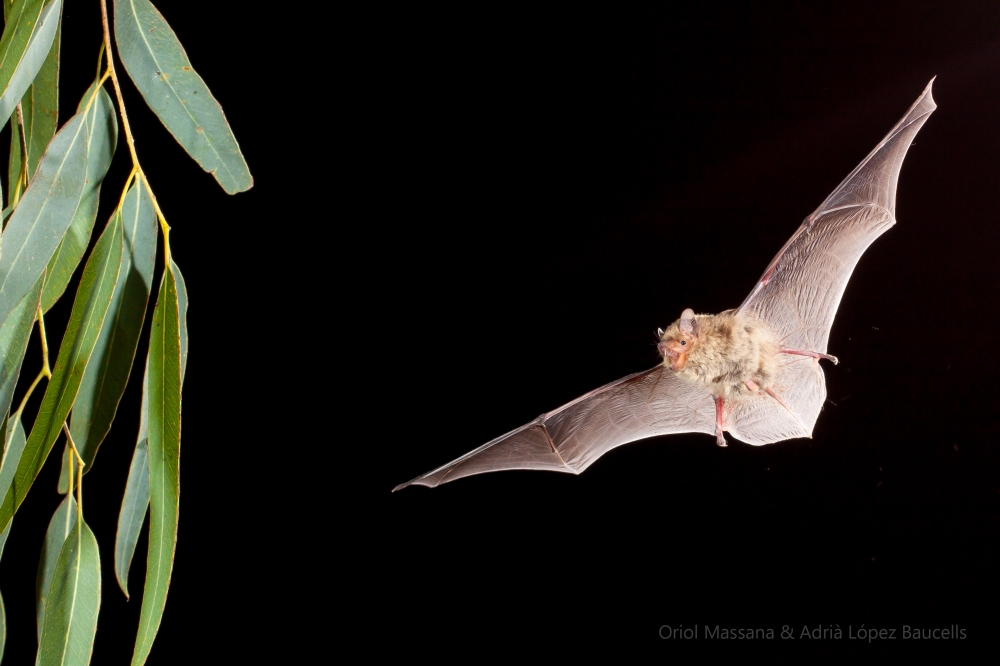Soprano pipistrelle bat

Pipistrellus pygmaeus (Leach, 1825)
Vespertilionidae
Least Concern
| Other names | |
|---|---|
| Catalan | Pipistrel·la nana |
| Spanish | Murciélago de Cabrera |
| English | Soprano pipistrelle bat |
| French | Pipistrelle pygmée |
| Basque | Pipistrelo mediterraneo |
| Galician | Morcego común |
Description
One of the smallest European bats from the Vespertilionidae family, with a head-body length between 36 to 51 mm, a wingspan of 190 to 230 mm, a forearm length between 27 and 33 mm, a tail between 37 and 48 mm and a weight of 4 to 7 grams. The fur is brown with the ventral part slightly lighter, with a sandy or beige colouration. Juveniles present a more uniform colouration than adults, usually greyish brown.
It can be differentiated from it's sister species, the common pipistrelle (Pipistrellus pipistrellus), because the Soprano pipistrelle has a lighter and more pink skin colouration around the eyes, snout and at the base of the ears. Another distinctive trait is that during mating season buccal glands turn bright orange. Similarly, both males and females present a yellow-orange colouration in their genitals.
Fotografies
Distribution
The distribution of this bat is mainly around the Mediterranean Sea, and it includes central and south Europe, Corsica, Sardinia and Sicily, and up to Great Britain. It's northern limit is in southern Norway, extending a little further than the common pipistrelle. In western Asia and eastern Europe it is found in Ucraine, Cyprus and the Caucasus, but it is absent in Crete.
Roosts and phenology
Breeding colonies of this species can be composed from tenths of individuals (15-20) up to hundreds (900 in Germany). One of the largest breeding populations in southern Europe can be found in the Ebro Delta, with a colony of more than 1,000 individuals (ChiroBoxes). Sometimes they can share their roosts with other species like the common pipistrelle (Pipistrellus pipistrellus) or the Nathusius' pipistrelle (Pipistrellus nathusii). Generally these breeding colonies are found in cracks in buildings, under roof spaces, expansion joints, rock crevices, tree holes and bat boxes. These colonies usually form in late spring and females give birth at the begining or middle June. Juveniles start flying after 3 to 4 weeks and abandon the colony after one and a half month. They reach sexual maturity in autumn.
It is considered a sedentary species, as they only perform short movements during migration to get to/from wintering and breeding roosts. Yet, in Europe movements of up to 1,280 km have been registered. In southern Norway they are known to form concentrations of up to 2,800 individuals, probably indicating a hibernation colony.
Habitat and diet
This species is completely adapted to humanized environments, even if it can also be found in forests, pastures, meadows and many other habitats. It has a clear preference for wetlands, such as marshes, litoral areas, riparian habitats and any riverine areas, avoiding agricultural areas and great field extensions. Depending on season and latitude, habitat selection can vary significatively. During breeding season wetlands become their main feeding grounds. In the Mediterranean and close to the Black Sea, they usually hunt in ponds, lagoons and coastal areas.
The diet of this species is mainly composed of small insects such as Dipterans (as Chironomids) and Hymenopterans, as well as Trichopterans , Coelopterans and Homopterans. They are extremely agile bats and can hunt under tree branches emerging fromt the water surface, in small forest clearings and above small water bodies. They generally concentrate their foraging activity during the first hours (1-2h) after sunset. Movements to the foraging grounds can vary a lot, but they are generally around 4-10 km from their roost. In Great Britain they can perform 1.7 to 10 km movements from their roost, while in Norway they can move up to 12 km and 800 m of altitude.
Echolocation
The echolocation is typical of the Pipistrellus genus, with calls that start modulated, finishing with quasi-constant frequencies (FM-QCF). The frecuency of maximum energy varies between 48 and 60 kHz, with a duration of around 12 ms. It's a species whose calls are very similar to those of the Schreiber's bent-wing bat (Miniopterus schreibersii) both for the frecuency level as for the shape of their calls. This makes that acoustically both species are grouped in the phonic group Pipistrellus pygmaeus/Miniopterus sp..
Yet, recent studies have proven that in zones with a high density of individuals and in absence of the common pipistrelle (like in the Ebro Delta), the Soprano pipistrelle can lower their frecuency range down to the one of the common pipistrelle (down to a minimum of 44 kHz).
A distinctive trait to tell these two species apart is the presence of social calls. The Soprano pipistrelles presents a group of 3 clustered calls at a frecuency between 19 to 20 kHz.
Trends
| General trend | Moderate increase |
|---|---|
| Protocol | ChiroHabitats |
| Geographic scope | Catalonia |
| Number of localities studied | 98 |
| Annual change | 7.7 % |
| Method | TRIM |
| Analysis execution date | 01/09/2024 |
Status
According to The IUCN Red List, this species is considered Least Concern with an unknown population trend. This species is protected by national laws directed by the Eurobat agreement, Bern Convention and EU Habitat and Species Directive. It is an abundant specie in its distribution in Europe. Its main threats include the predation by domestic animals, the loss of available roosts because of deforestation and the renewal of buildings that can affect the largest colonies of this species.



